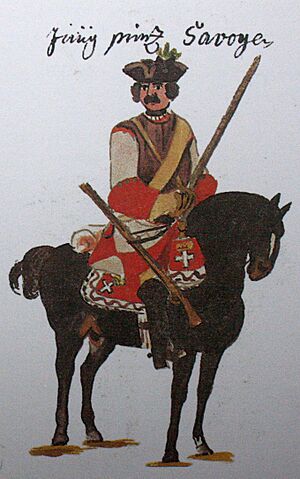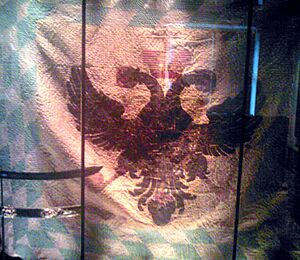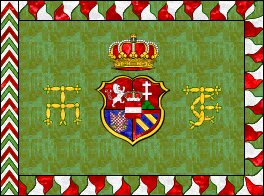Imperial Army (Holy Roman Empire) facts for kids

The Imperial Army (also known as Kaiserliche Armee in German) was a special name for soldiers who served the Holy Roman Emperor for many centuries. This army was the Emperor's personal force. It's important not to confuse it with the Army of the Holy Roman Empire (called Reichsarmee). That army belonged to the entire Holy Roman Empire and could only be used if the Imperial Diet (a kind of parliament) agreed.
Over time, the Imperial Army became like a regular, standing army for the Habsburg Emperors. These Emperors were from the House of Austria. Because of this, people in the 18th century often started calling these soldiers "Austrians." However, the troops actually came from all over the Holy Roman Empire, not just from Austria.
Contents
The Emperor's Own Army
For a long time, most Holy Roman Emperors came from the Habsburg monarchy. Being an Emperor was a personal title, not tied to a specific piece of land.
So, the Imperial Army was created by the Emperor himself. It had special rights across the whole Holy Roman Empire. The Emperor could not raise troops in the areas ruled by powerful princes (called electoral states). But he could recruit soldiers in imperial cities and other territories.
Separate from the Emperor's own army, the Imperial Diet could also create the Army of the Holy Roman Empire. This "army of the empire" would be formed if there was a major war involving the whole Empire.
Changes and the "Austrian" Name

Between 1740 and 1742, there was a time when the Habsburgs didn't hold the Imperial crown. During this period, the Habsburg troops served the Queen of Hungary, Maria Theresa. She was fighting for her family's power in Europe during the War of the Austrian Succession.
Maria Theresa's husband, Francis Stephen, lost the Imperial crown at first. Charles VII from Bavaria became the Emperor. So, from 1742 to 1745, soldiers from Electorate of Bavaria briefly formed the Imperial Army.
In 1743, Maria Theresa changed the color of officers' sashes and regimental flags to green instead of gold. Gold had always been a color linked to the Emperor.
After 1745, Maria Theresa's husband, Francis I, became Emperor. The Habsburg troops got their Imperial status back. Maria Theresa took the title of Empress, but she didn't put much importance on being crowned Empress herself. Her army was then called "Roman Imperial-Royal."
However, people started using the shorter, more common term "Austrian" for these troops. This happened especially during the Seven Years' War (1756-1763) and later conflicts.
Over time, people in Prussia and Protestant areas became less interested in the idea of a single, universal Empire. This had previously given the Imperial troops their special standing. Even Maria Theresa's son, Emperor Joseph II, focused more on strengthening Austria as a separate state.
In 1804, the Austrian imperial crown was created. Just two years later, Francis II, Holy Roman Emperor officially ended the Holy Roman Empire. It had become less and less powerful by then.
What the Imperial Army Did
During the early modern period, the Imperial Army fought in many wars that affected the Holy Roman Empire. They often fought alongside the Army of the Holy Roman Empire and other local armies. Some of these wars included:
- Italian Wars (1494-1559)
- Long Turkish War (1593–1606)
- Thirty Years' War (1618–1648)
- Second Northern War (1655–1660)
- Austro-Turkish War (1663–1664)
- Nine Years' War (1688–1697)
- Great Turkish War (1683–1699)
- War of the Spanish Succession (1701–1714)
- War of the Polish Succession (1732–1738)
How the Imperial Army Grew
- Further information: Hofkriegsrat
The Thirty Years' War caused the Emperor's army to grow very large. In 1635, the Imperial Army had about 65 regiments of foot soldiers. Each regiment was supposed to have 3,000 men. During the war, many regiments were formed and then disbanded. By 1648, only a small number of regiments remained.
The army's official size (on paper) grew from about 61,900 soldiers in 1625 to 150,900 in 1630. However, the actual number of soldiers ready to fight was often lower. This was due to illness and soldiers leaving the army.
Over time, because of so many wars, the Imperial Army slowly became a permanent army. Many new regiments were formed in the late 1600s.
Here are the average numbers of soldiers in the Emperor's military forces during some major wars:
- Austro-Turkish War (1662–1664): 82,700 soldiers (51,000 from the Imperial Army, 31,700 from the Reichsarmee)
- Franco-Dutch War (1672–1679): 132,350 soldiers (65,840 from the Imperial Army, 66,510 from the Reichsarmee)
- Great Turkish War (1683–1689): 88,100 soldiers (70,000 from the Imperial Army, 18,100 from the Reichsarmee)
- Nine Years War (1688–1697): 127,410 soldiers (70,000 from the Imperial Army, 57,410 from the Reichsarmee)
- War of the Spanish Succession (1701–1714): 260,090 soldiers (126,000 from the Imperial Army, 134,090 from the Reichsarmee)
The Habsburgs often found it hard to convince other parts of the Empire to help pay for the army. They had the most success during the War of the Spanish Succession. In that war, the total cost was huge. About 14% of the cost was covered by allies like Britain and the Netherlands. The Habsburgs paid about 29%, and the rest (57%) was paid by other states within the Empire.
Types of Units
The Imperial Army included various types of soldiers, such as:
- Grenz infantry (border infantry)
- Pandurs (irregular soldiers, often from the Balkans)
- Trenck's Pandurs (a famous unit of Pandurs)
- Seressaner (another type of border guard)
- Serbian military units, like the Serbian Militia and Serbian Free Corps.
See also
- Kaiserlich (explains the concept of "Imperial")
- Army of the Holy Roman Empire
- Austrian Army during the French Revolutionary and Napoleonic Wars
- Imperial Austrian Army (1806-1867)
- Armed Forces of Austria-Hungary
- Austro-Hungarian Army
- Common Army
|


